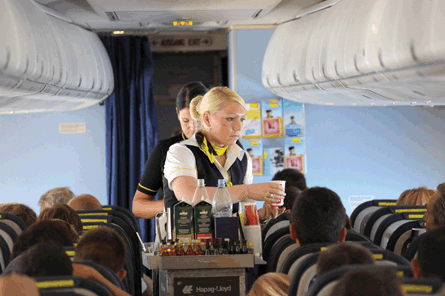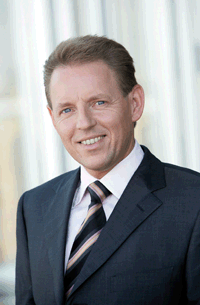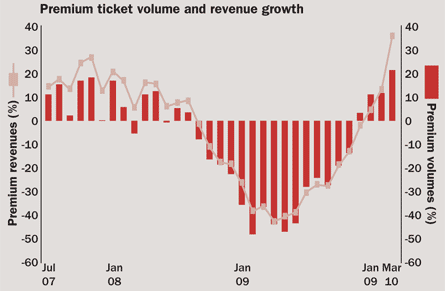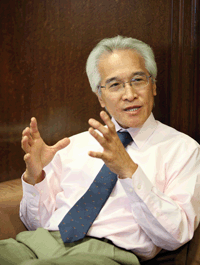Aviation is a cyclical industry; few would argue with that. But as GDP and traffic once again begin their upward climb, delegates at this year's AGM will be questioning whether yields are going to join the party. After all, a full aircraft is not necessarily a profitable one.
"The crisis we are facing is a yield crisis, not a utilisation crisis," says Lufthansa chief financial officer Stephan Gemkow. "The seat load factor for the network as a whole was 77.9% in 2009, which is merely one percentage point less than 2008. At the same time, however, average yield declined by 12%." Short-haul routes were most seriously affected. "With stable load factors, the average yield fell 17.4%," he laments.
Lufthansa is not alone. Glimpsing through a few major airline yield results for 2009, some saw slumps of up to 20%. And IATA's latest Premium Traffic Monitor brings mixed news for 2010. Starting with the positive, IATA reports that tighter management of supply and demand has lifted yields from their mid-2009 doldrums, generating record load factors. But while first quarter premium yields were 10% up on 2008, they were "still well down on pre-recession levels" and have not kept pace with the demand recovery, says IATA.
 |
|---|
© Action press/Rex Features |
STRUCTURAL SHIFT
So, has the economic crisis had a structural effect on yields? The answer seems to vary by region - in keeping with IATA's observations of an asymmetrical recovery - as well as by business model, aircraft cabin and sector length.
Looking firstly at Europe, which is host to this year's AGM, the region's sluggish recovery, currency crisis and ash plume mean pessimism is very much the mood of the day. "Never bet on yields in our industry. And, if you have to bet on them, bet on them going down," is the bleak message from Wizz Air chief financial officer Michael Powell.
 |
|---|
"The crisis we are facing is a yield crisis, not a utilisation crisis,"Stephan GemkowLufthansa chief financial officer |
On short- and medium-haul services, where low-cost competition is rife, many European carriers have conceded that business class is virtually dead. This comes as IATA chief economist Brian Pearce warns of "a steady and structural shift" of business travellers from premium to economy seats. But he adds: "That is not the case on long-haul routes, where the decline that we've seen in premium and business seems to be cyclical and we're starting to see that come back."
But KLM chief executive Peter Hartman notes that while long-haul premium traffic is indeed coming back, yields remain down: "On long-haul we are seeing business travellers coming back to pre-2008 levels. But yields won't come back to the old levels. We expect on average 10% lower yields."
MARKET RESPONSE
Air France-KLM is responding to this structural market change by launching a major repositioning of its medium-haul product. From April this saw it introducing a premium economy class and reducing prices across the board. Chief executive Pierre-Henri Gourgeon says: "We've reduced our prices on the medium-haul quite significantly, which is why we've seen an increase in reservations. Our conclusion is that our commercial approach is the right one."
From October Air France and KLM also began offering a premium economy class on their long-haul fleets. As carriers like British Airways, Virgin Atlantic and Air New Zealand have found, where the volume justifies this "economy plus" or "business minus" cabin, the yield benefit can be well worthwhile. Air France-KLM is seeing a similar picture in its early results. "The revenue per passenger is 2.2 times higher than in economy class over the first few months," says Gourgeon.
The picture is mixed across the cabins and airlines are employing differing strategies to coax yield growth. Virgin Atlantic chief commercial and financial officer Julie Southern is focusing on a raft of revenue integrity initiatives. "We are making sure we manage inventory in a smart way, minimising spoilt inventory by deleting duplicates, as well as incentivising agents to make robust bookings and cancel test bookings. We are also being more sophisticated about origin and destination management. We are deploying tools which will enable us to manage these things more dynamically."
Southern believes things are "definitely looking up" and she is forecasting a "gentle yield improvement curve". But she adds: "It is nothing like our peak levels and it's probably too early to say whether and when we will achieve those again."
Virgin's ASKs are 11% down on 2008 and Southern stresses it is essential for airlines to control capacity, as they have done over the last 12-18 months, to keep ticket prices at sensible levels. "Demanding more for less continues to be a feature of aviation," she says. "Am I concerned capacity discipline will fade away? Yes, because that is the trend of the industry. But there hasn't been any signs of a mass rush of aircraft coming back to the market yet because we are still in recovery mode."
 |
|---|
In stark contrast with Virgin, Emirates has taken an extremely bullish approach to the downturn. "We took a pasting in the early part of 2009," confesses president Tim Clark. Therefore Emirates slashed 16% from its cost base so it could offer a more aggressively priced premium product.
"Our unit costs fell, we grew our capacity and we were able to absorb lower yielding, but higher volumes, in premium," says Clark. "We actually grew the seat factors in premium classes because all sorts of people came to us who hadn't been able to afford the pricing prior to the meltdown."
Some analysts suggest Gulf carriers have depressed yields, for instance between London and Asia, by pumping in capacity and discounting premium fares. But Clark is unrepentant about not shrinking his network or grounding aircraft. "The airline community has knee jerk reactions to crises. Frankly I've been in it too long now and I'm not going to do this anymore. We don't need to do this. In the end if you have a good product and you offer value for money, that's the most important thing. People will come back."
He argues that "the price we were charging for the premium offering in the old days was far too high" and some airlines have "got themselves into the trap" of depending too heavily on high-yielding passengers to support their weighty cost base, leaving themselves "effectively beached" when this revenue stream dries up.
And, despite the critics, it seems like the Emirates strategy has paid off. "We pushed the fares up 35% last year between April and December in the light of everyone else going south. Our business cabins remained full, albeit we were getting less money, but this is what you have to do in business. You can't expect it to be a bed of roses all the time. We now have pricing about the same as in the first quarter of 2008, which is already a good yield. Take the cost out, and bingo, profits come along as they have done."
Another carrier bucking the market trend is Ryanair, which has just doubled its annual profits in one of the worst years on record. While yields were down 13% for the year ended March 2010, this was not as sharp 20% fall it originally feared. Volcanic ash disruption will lower Ryanair's yields in the first quarter of its current financial year, but it expects to be able to recoup a large portion of these lost yields.
"We are cautiously optimistic on the coming year," says chief executive Michael O'Leary, who is expecting his average fares to rise 5-10% for the year to March 2011. "If that happens then we expect profits to rise 10-15%."
LONGER SECTORS
But part of this yield improvement reflects Ryanair's more mainstream airport bases of late, such as Malaga, Faro and most recently Barcelona El Prat, which offer higher peak season yields at the expense of longer sector lengths.
"The big opportunity for us is the new bigger airports. We are also doing fewer really cheap discounts." But while these bases are already producing strong yields for the summer season, O'Leary says he has "no visibility" on how these routes will perform in the winter season.
Ryanair's counterpart on the other side of the Atlantic, Southwest, is also upbeat about yield performance. First quarter load factors at the US low-cost giant rose six points to 75.9%. "Normally when we see traffic and load factors rise, it is at the expense of yields," says chief executive Gary Kelly. "Our yields were up 9.1%, which again is really helping to drive our revenue performance, just outstanding all the way around." And the improvement is getting stronger. January yields were flat, February saw a 9% improvement and March brought a 16% jump.
 |
|---|
© Law Kian Yang"Yields have yet to get up to pre-crisis level, but the trend is in the right direction and we are much heartened by that"Chew Choon SengChief executive Singapore Airlines |
AirTran chief executive Bob Fornaro is also welcoming the upturn, after his carrier posted its first increase in quarterly yields since 2008. Like Southwest, Fornaro says the yield improvement accelerated during the quarter, culminating in a solid double-digit increase in unit revenue performance in March. "Our yields continued to trend upward and remain strong," says the carrier's chief financial officer Arne Haak. "We are expecting our total unit revenue to increase 13-14% in the second quarter."
Meanwhile, JetBlue chief financial officer Dave Barnes says his carrier has benefited from positive pricing traction across all markets, although he still sees considerable difference in demand during peak and off peak periods.
Although the USA is a mature market like Europe, the mood is noticeably more upbeat - and not only among the low-cost crowd.
AMR chief financial officer Tom Horton says "yields are trending up significantly versus last year", United president John Tague notes that first quarter international unit revenues were up by an "impressive" 30%, as corporate travel begins to return and US Airways, president Scott Kirby talks about the "strong year-over-year pricing environment" and "improving corporate demand".
But others are less optimistic. "Year-over-year comparisons for the first quarter were pretty easy," says Continental chief marketing officer Jim Compton. "On a year over two-year basis, both trans-Atlantic and trans-Pacific business first load factors were up several points, but yields were still negative. However, the yield trends are headed in the right direction."
And, as all eyes look to Asia as one of the hot spots for the recovery, it has not escaped unscathed. One of the region's carriers hardest hit in yield terms is Cathay Pacific, which saw yields plummet by almost 20% in 2009, putting it below 2006 levels. Singapore Airlines also suffered, with yields down 16.8%. But SIA chief executive Chew Choon Seng is encouraged by advance bookings for the next 12 months and yields are now looking encouraging. "There's a pronounced recovery in demand for travel in business class. And yields have been retracing the losses. Yields have yet to get up to pre-crisis level, but the trend continues to be in the right direction and we are much heartened by that," says Chew.
Although we are seeing differing paces of recovery, capacity control and yield management remain top of the senior management agenda. Chew concludes: "The challenge for us is to sustain the recovery not just in loads but also in yields. So by having a judicious rate of growth, it is our aim to keep load factors at a level which are above breakeven and yet allow us to recover more of the yield loss."
Source: Flight Daily News























